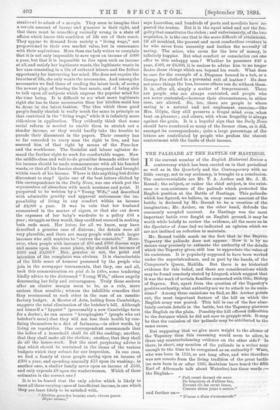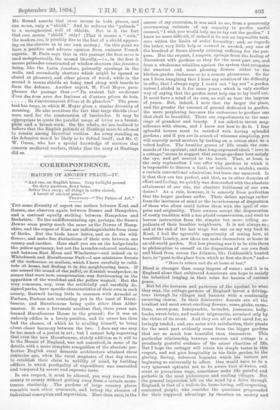THE PALISADE AT THE BATTLE OF HASTINGS,
IN the current number of the English Historical Review a controversy which has been carried on in that periodical as well as in the Quarterly and the Contemporary with no little energy, not to say acrimony, is brought to a conclusion. The controversialists are Mr. T. A. Archer and Mr. J. H. Round ; the subject, or rather the chief subject, is the exist- ence or non-existence of the palisade which protected the English position at the Battle of Hastings. This palisades
which has figured, we believe, in every recent account of the battle, is declared by Mr. Round to be a creation of the-
imagination ; Mr. Archer, on the other hand, defends the commonly accepted account. As Hastings was the most important battle ever fought on English ground, it may be worth while briefly to review the evidence, all the more as in the Spectator of June 2nd we indicated an opinion which we- are not inclined on reflection to maintain.
Mr. Round builds much on the fact that in the Bayeux Tapestry the palisade does not appear. Now it is by no means easy precisely to estimate the authority of the details- which the Tapestry gives, still lees to appreciate the value of
its omissions. It is popularly supposed to have been worked under the superintendence, and in part by the hands, of the Conqueror's Queen, Matilda. But there is no historical evidence for this belief, and there are considerations which may be found concisely stated by Lingard, which suggest that
it was the work of certain families connected with Odo, Bishop, of Bayeux. But, apart from the question of the Tapestry's positive authority, what authority are we to attach to its orals. talons P Among these omissions we find, as Mr. Archer points out, the most important feature of the hill on which the English army was posted. This hill is one of the few abso- lutely certain details in the battle, but the Tapestry pictures the English on the plain. Possibly the hill offered difficulties to the designer which he did not care to grapple with It may- be that the omission of the palisade may be attributed to the same cause.
But supposing that we give more weight to the silence of the Tapestry than this reasoning would seem to allow, is there any counterbalancing evidence on the other side P Is there, in short, any mention of the palisade in a writer near enough to the time to be recognised as an authority P Wace, who was born in 1110, or not long after, and who therefore was not remote from the living tradition of the great battle (as men born in or alter 1865, doubtless have heard the fifth Earl of Albemarle talk about Waterloo) has these words
the English- " Fait orent devaut els escuz De fenestres at d'altres fur, Devant els lee orent leuez, Comme cleies joins o serrez."
and further on- "D'escuz a dais s'avironoent." Bfr. Round asserts that (Boaz means in both places, and an mean, only a " shield." And he reduces the " palisade " to a metaphorical wall of shields. But is it the fact that emu, means " shield " only P (That it means a "coin," the modern 6c74, is possibly due to the fact of a shield appear- ing on the obverse as in our own money.) On this point we have a positive and adverse opinion from eminent Frauds experts. M. Paris says that in this passage the first CMOS is used metaphorically, the second in the first it means palisades constructed of window-shutters (the fenestres being, like the Latin feneatrae, primarily openings in the walls, and secondarily shutters which might be opened or closed at pleasure), and other pieces of wood; while in the second it means shields as being used along with boards to form the defence. Another expert, M. Paul Meyer, para. phrases the passage thus :—" Ils avaient fait aradevant d'eux des &us avec des fenetres et d'autres pieces de boils.
• . . . . us s'environnaient d'ecus et de planches." The prose text has targe, to which M. Meyer gives a similar diversity of meaning. He also mentions the fact that large shields (ems) were used for the construction of barricades. It may be appropriate to quote the parallel usage of Zorica as a breast- plate and a breast-work. On the whole, we-are inclined to believe that the English palisade at Hastings must be allowed to remain among historical verities. An army standing on the defensive would be likely so to defend itself; and Mr. 0, W. Oman, who has a special knowledge of matters that -concern mediasval warfare, thinks that the army at Hastings did so.







































 Previous page
Previous page